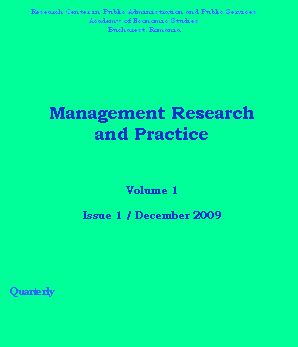
BUSINESS EXCELLENCE AND MANAGEMENT
ISSN
2248-1354 (print)
2668-9219 (online)
ISSN-L: 2248- 1354
|
Home |
|
| Journal description | |
| Aims and scope | |
| Publication ethics | |
| Indexation | |
| Editorial information | |
| Editorial team | |
| Editorial Board | |
|
Journal content |
|
| Current issue | |
| Previous issues | |
| Special issues | |
| Guideline for authors | |
| Submission | |
| Manuscript style | BEMAN Template |
|
|
| Volume 7, Issue 4, December 2017 |
|
1. EFFICIENCY ANALYSIS OF BANKING SECTOR IN REPUBLIC OF SERBIA
Radojko LUKIC Serbia Miro SOKIC Dunav Insurance Company a.d.o., Belgrade Serbia
Dragana Vojteski
KLJENAK
Serbia |
|
Efficiency of the banking sector has, due to its significance, lately been increasingly analysed by individual countries, through the application of modern economic and mathematical methods and models. This is the case with the banking sector in the Republic of Serbia, as well. For this particular reason, the paper deals in a 2016 efficiency analysis of the banking sector of the Republic of Serbia by applying the Data Envelopment Analysis (DEA) analysis. The obtained results of the survey conducted on the sample of thirty (30) banks show that only eight (8) banks were business efficient. With the view of increasing the future business efficiency of the entire banking sector (in particular of the inefficient banks),it is necessary to more efficiently manage the assets and liabilities, human resources, capital, operating income and profit. Moreover, there is a need for a more efficient cost management through the application of modern concepts, such as cost accounting by activities and/or Japanese business philosophy... |
|
2. FINANCIAL INCLUSION- A COMPARATIVE STUDY ON SOUTH ASIA
S M Rakibul ANWAR Bangladesh Tanzina Tabassum TANZO University of Chittagong, Chittagong Bangladesh
Riduanul MOSTAFA Bangladesh
|
|
This paper aims to construct an index of financial inclusion (IFI) in South Asian countries. Despite the growing recognition of financial inclusion across countries, the literature on measuring financial inclusion position among the South Asian countries is still scanty. Initially, the index of financial inclusion is calculated for 6 countries of the South Asian Countries for 2004 to 2015 using the data provided by financial access survey of International Monetary Fund (IMF) and Global findex database and finally Sarma model (2008) to compute Index of Financial Inclusion (IFI). Sarma model (2008) includes three dimensions of financial inclusion, which are: banking penetration, availability of banking services and usage of banking system. This paper reflects the comparative position of financial inclusion among the countries in the South Asia. From the index calculated, it is noticed that the position of India and Bhutan are good in comparison on other countries in South Asia but the Pakistan and Afghanistan are lag behind in financial inclusion due to lacks of usages of formal financial services by their country people. So, there are lots of scopes for improvement of financial inclusion position of these countries massively... |
Other ASE journals


